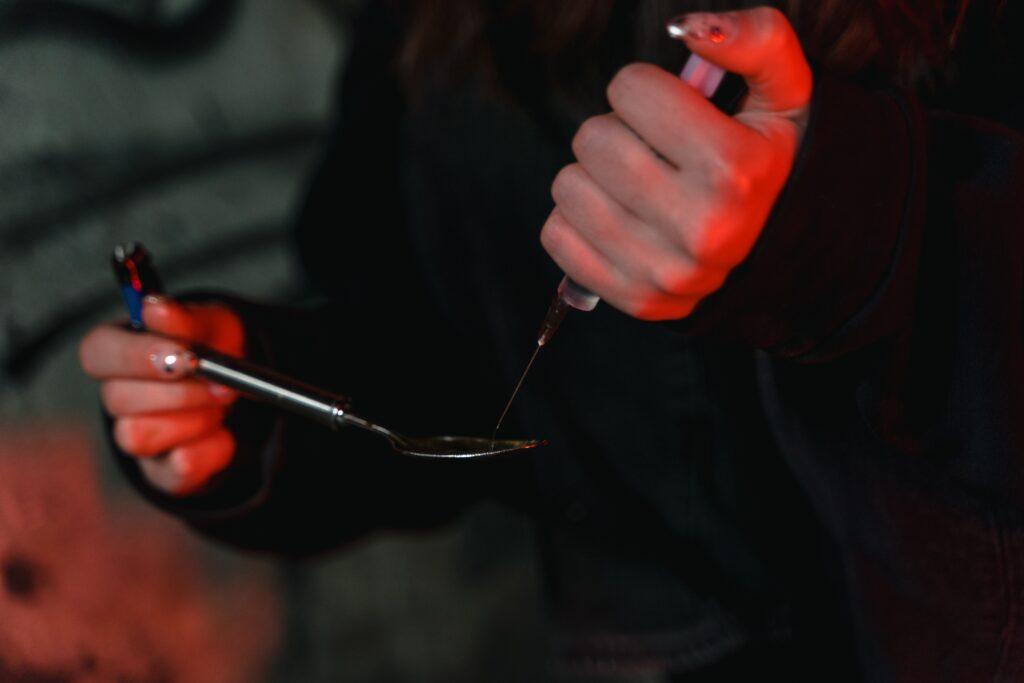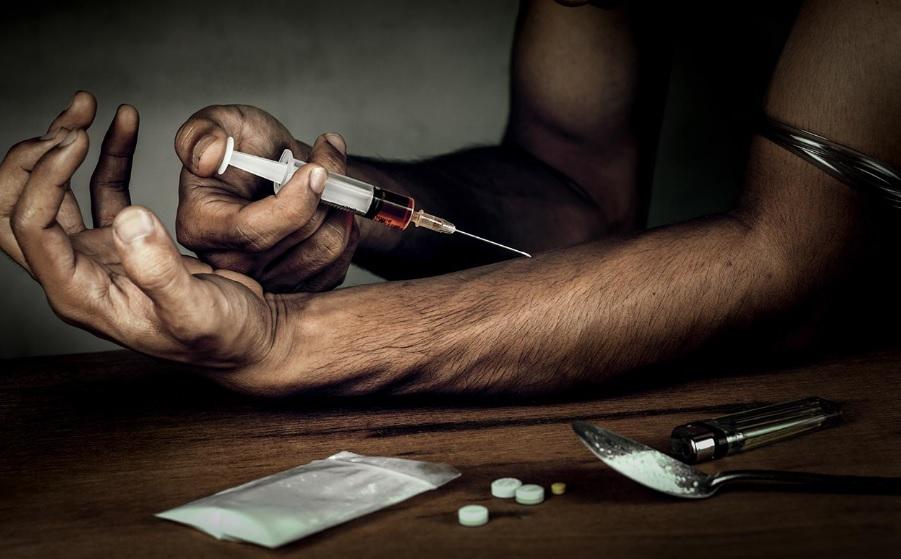What Are The Dangers of Shooting Meth?
Shooting meth, or injecting or slamming, is a particularly dangerous drug method. Methamphetamine is a powerful stimulant that affects the central nervous system, and injecting it directly into the bloodstream can have severe and immediate consequences.
Here are some of the dangers of shooting meth:
- Increased risk of overdose: Injecting meth results in an intense and immediate high, which can easily lead to an overdose. The purity and potency of the drug can vary widely, and users may not be able to gauge the amount they are injecting accurately. An overdose can cause seizures, heart attack, stroke, coma, and even death.
- Infection and disease transmission: Injecting meth requires using needles and other injection equipment, which increases the risk of infection and disease transmission. Sharing needles can spread HIV, hepatitis B and C, and other blood-borne diseases.
- Vein damage: Injecting meth can damage veins and lead to collapsed veins, making it more difficult to inject drugs or receive medical treatment in the future. This can also result in the formation of abscesses or blood clots, which can be painful and lead to further complications.
- Skin damage: Injecting meth can also cause skin damage, as users may repeatedly inject in the same area or use dirty needles that introduce bacteria into the skin. This can result in skin infections, ulcers, or scarring.
- Mental health issues: Meth use can cause or worsen mental health issues, such as anxiety, depression, paranoia, and psychosis. Injecting meth can intensify these effects and lead to more severe or prolonged episodes of mental illness.
- Addiction: Meth is a highly addictive drug, and injecting it can increase the risk of addiction. The intense and immediate high of injecting can create a powerful urge to use the drug again, leading to a cycle of addiction that can be difficult to break.
- Legal consequences: Possession, use, and distribution of meth are illegal in most countries. Injecting meth can result in arrest, incarceration, and legal fees and damage relationships, employment, and other aspects of life.
In conclusion, shooting meth is a dangerous and potentially deadly practice with various physical, mental, and legal consequences. Anyone struggling with meth addiction should seek professional help to overcome the addiction and avoid the risks of drug use.
Why Do People Shoot Meth?
Yes, people do shoot up methamphetamine, a powerful and highly addictive stimulant drug that affects the central nervous system. Shooting up meth, also known as injecting or slamming, is a particularly dangerous and risky drug method.
Here are some of the reasons why people shoot up meth:
- Intense and immediate high: Injecting meth delivers an intense and immediate high that is more powerful and faster-acting than other drug methods, such as smoking or snorting. This rush of pleasure and energy can be addictive and lead to a cycle of repeated use.
- Increased potency: Injecting meth bypasses the digestive system and delivers the drug directly into the bloodstream, resulting in a higher concentration in the body. This can increase the drug’s potency and lead to a more intense high.
- Peer pressure: People who use meth in social settings may feel pressure to shoot up the drug to fit in or keep up with others. This can lead to a greater likelihood of engaging in this risky behavior.
- Previous drug use: People who have already been using meth through other methods may switch to injecting the drug to intensify the high or break-through tolerance.
- Addiction: Meth is a highly addictive drug, and people who become addicted to it may inject it to increase the intensity of the high and satisfying cravings.

Skip To:
Learn More:
- Is There a Meth Poem? My Name is Meth & Drug Rehab
- Pink Meth, Dangers, Effects & Rehab Treatment
- What is Blue Crystal Meth? Blue Sky Meth
- How Long Does Meth Stay in Your Blood?
- How Long do Crystal Meth Stay in Your System?
- How to Get Meth Out of Your System?
- Meth Before and After. Pictures of Meth Users Before and After Show Horrific Changes.
- What are Bongs for Meth?
- Adderall vs Meth: What’s the Difference?
- Meth Mouth Sores Pictures. What Causes Meth Mouth Sores & Ulcers. How to Treat Meth Mouth Sores?
Get Help. Get Better. Get Your Life Back.
Searching for Accredited Drug and Alcohol Rehab Centers Near You?
Even if you have failed previously and relapsed, or are in the middle of a difficult crisis, we stand ready to support you. Our trusted behavioral health specialists will not give up on you. When you feel ready or just want someone to speak to about therapy alternatives to change your life call us. Even if we cannot assist you, we will lead you to wherever you can get support. There is no obligation. Call our hotline today.
(844) 597-1011Popular Shooting Meth Related FAQs
-
Do People Shoot Up Meth?
Yes, people do shoot up methamphetamine, a powerful and highly addictive stimulant drug that affects the central nervous system.
-
How Do People Shoot Meth?
To shoot up meth, the drug is dissolved in water and injected into a vein using a needle and syringe. This can be done by drawing the solution into the syringe, tapping out any air bubbles, and injecting the drug into a vein, typically in the arm. Some people may inject the drug into a muscle, known as an intramuscular injection. However, injecting into a vein results in a more immediate and intense high.
-
Can You Shoot Meth?
Yes, methamphetamine can be injected, also known as shooting up, slamming, or injecting. However, this method of use is highly dangerous and carries a range of physical, mental, and legal risks.
Methamphetamine Factsheet
What is Methamphetamine?
Meth is a highly addictive stimulant that can cause addiction in as little as a single use. This is mainly due to the rush of dopamine produced by the drug. Dopamine is a chemical that’s not only responsible for inducing feelings of pleasure but also for motivation, memory retention, learning, and reward processing. The rush of dopamine produced by Meth is much higher than the natural amount of dopamine produced in the brain, which causes people to continue using the drug to keep those heightened and pleasurable feelings.
Methamphetamine Effects
Abuse of methamphetamine includes any illegal usage of the drug. When smoked or injected, meth causes a “rush” similar to that experienced when using crack cocaine; this is brought on by increased heart rate, blood pressure, and pleasure-inducing neurotransmitters in the brain. Snorting meth produces an ecstatic feeling but not a rush.
The infusion rush produces the biggest effects, lasting up to 30 minutes. Depending on the drug’s use, users enjoy a sustained high that can continue between 8 and 24 hours after the first surge. Meth injection delivers a higher high than smoking or snorting it, although it lasts less.
Street Names for Methamphetamine
Meth and Crystal Meth are chemically identical substances, despite the differences in the structural composition of the two varieties. Methamphetamine goes by the following street names:
- Glass.
- Speed.
- Ice.
- Crystal.
- Crank.
- Tweak.
- Redneck Cocaine.
- Chalk.
The vast bulk of meth sold today comes from imports and clandestine labs. A few people often generate modest amounts of the material in “home labs” or “stove tops,” where the product is typically cooked. Meth is also made in cartel “super labs,” which use high-end machinery to generate the drug in greater quantities and with superior quality.
The stimulant Ephedrine or Pseudoephedrine, present in certain popular over-the-counter cough and cold treatments, is often the main component in meth. Meth labs are famously hazardous due to the toxic and flammable gases and chemicals generated during the production of the drug.
Methamphetamine Statistics
Methamphetamine is a highly addictive and dangerous drug that poses significant risks to the health and well-being of individuals who use it. Despite the many negative consequences of meth abuse, the problem continues to affect communities across the United States and worldwide.
In recent years, studies and research have shed light on the scope and impact of meth abuse, highlighting the urgent need for effective prevention, treatment, and intervention strategies. This section will examine some of the latest statistics and findings on meth abuse, drawing from recent studies and reports.
550 Million
Meth costs the United States $550 million in drug treatment programs annually.
Source: NIDA
16 Million
According to the 2017 National Survey on Drug Use and Health, 1.6 million people reported using Meth in the past year.
Source: NIDA
964,000 People
An estimated 964,000 people aged 12 and older qualified as having a Meth use disorder in 2017.
Source: NIDA

Get Your Life Back
Find Hope & Recovery. Get Safe Comfortable Detox, Addiction Rehab & Dual Diagnosis High-Quality Care.
Hotline(844) 597-1011How Do People Shoot Up Meth?

Injecting methamphetamine, also known as shooting up, slamming, or injecting, is a highly dangerous and risky method of drug use that can lead to a range of physical, mental, and legal consequences. However, despite the risks, some people may choose to inject methamphetamine due to the intense and immediate high that results from this method of use.
Here is a more detailed explanation of how people shoot up meth:
- Preparing the drug: To inject meth, the drug is typically dissolved in water. Some people may use other liquids, such as alcohol or vinegar, to dissolve the drug. The water will depend on the meth used and the user’s preference.
- Preparing the injection site: Once the drug is dissolved in water, the user must prepare the injection site. This typically involves cleaning the area with alcohol or another disinfectant and tying off the arm with a tourniquet to make the veins more visible and accessible.
- Drawing up the solution: The next step is to draw the meth solution into a needle and syringe. The user will typically use a small needle, such as a 30-gauge needle, to inject the drug. The needle is inserted into the solution, and the plunger is pulled back to draw the liquid into the syringe.
- Injecting the drug: Once the solution has been drawn up, the user will typically tap the syringe to remove any air bubbles and inject the drug into a vein. The needle is inserted into the vein, and the plunger is slowly depressed to inject the solution. Users may experience intense pleasure and energy as the drug enters the bloodstream.
- Disposing of the equipment: After injecting the drug, it is important to properly dispose of the used needle and syringe to avoid the risk of infection or disease transmission. Needles and other drug equipment should never be shared, as this can increase the risk of transmitting blood-borne diseases such as HIV or hepatitis.
It is important to note that injecting methamphetamine is a highly dangerous and risky method of using the drug. Injecting the drug can lead to various physical, mental, and legal consequences, including overdose, vein damage, skin damage, mental health issues, addiction, and legal problems. Additionally, sharing needles or other drug equipment can lead to the transmission of blood-borne diseases. Anyone struggling with meth addiction should seek professional help to overcome the addiction and avoid the risks of drug use.
First-class Facilities & Amenities
World-class High-Quality Addiction & Mental Health Rehabilitation Treatment
Rehab Centers TourRenowned Addiction Centers. Serene Private Facilities. Inpatient rehab programs vary.
Addiction Helpline(844) 597-1011Proven recovery success experience, backed by a Team w/ History of:
15+
Years of Unified Experience
100s
5-Star Reviews Across Our Centers
10K
Recovery Success Stories Across Our Network
- Low Patient to Therapist Ratio
- Onsite Medical Detox Center
- Comprehensive Dual-Diagnosis Treatment
- Complimentary Family & Alumni Programs
- Coaching, Recovery & Personal Development Events
How To Stop Shooting Up Meth?
Stopping meth shoot, or injecting methamphetamine, can be extremely challenging, as this method of use can lead to physical and psychological dependence. Here are some steps that can help someone stop shooting up meth:
- Seek professional help: Quitting meth shoot can be difficult, and many people may require professional help to overcome the addiction. Treatment options include medication-assisted treatment, behavioral therapy, support groups, and residential treatment programs.
- Build a support system: It is important to surround yourself with supportive people who can offer encouragement and accountability. This can include friends, family members, support groups, or a sponsor in a recovery program.

- Find healthy ways to cope: Meth use may have been a way to cope with stress or emotional pain, so it is important to find healthy ways to cope. This can include exercise, meditation, therapy, or engaging in hobbies or activities that bring joy and fulfillment.
- Avoid triggers: Triggers are people, places, or situations that may increase the urge to use meth. Avoiding or developing a plan to cope with these triggers can help prevent relapse.
- Practice self-care: Taking care of yourself physically and mentally can help reduce the urge to use meth. This can include getting enough sleep, eating a healthy diet, and engaging in activities that promote relaxation and stress reduction.
Remember, quitting meth shoot is a process that requires patience, commitment, and effort. Seeking professional help and building a support system can greatly increase the chances of success.
World-class, Accredited, 5-Star Reviewed, Effective Addiction & Mental Health Programs. Complete Behavioral Health Inpatient Rehab, Detox plus Co-occuring Disorders Therapy.
CALL(844) 597-1011End the Addiction Pain. End the Emotional Rollercoaster. Get Your Life Back. Start Drug, Alcohol & Dual Diagnosis Mental Health Treatment Now. Get Free No-obligation Guidance by Substance Abuse Specialists Who Understand Addiction & Mental Health Recovery & Know How to Help.
We Level Up Shooting Meth Dual Diagnosis Treatment
The definition of dual diagnosis (also referred to as co-occurring disorders) can differ between institutions. However, it is generally described as the specific treatment of someone diagnosed with a substance use disorder and a mental health disorder simultaneously. Treating dual-diagnosis clients is a critical aspect of our inpatient treatment experience because co-occurring disorders are strongly correlated with instances of substance abuse.
Creating a treatment plan that addresses the physical aspects of withdrawal, the psychological connection with drug use, and managing underlying mental health disorders is part of setting clients up for success. A thorough mental health analysis identifies possibilities for treatment. Meeting with mental health counselors and medical care providers means access to behavioral therapy and medication treatment. At our dual diagnosis treatment center, We Level Up can implement the highest quality of care.
We recognize the fragile complexities of how mental and substance abuse disorders can influence others and sometimes result in a vicious cycle of addiction. That’s why we offer specialized treatment in dual-diagnosis cases to provide the most excellent chance of true healing and long-lasting recovery.
Accepting that you may be living with a mental illness can be challenging. However, treating the presenting substance abuse case can be magnitudes easier once properly diagnosed and treated. Only a properly trained medical professional can diagnose these underlying conditions. If you believe you are suffering from a disorder alongside addiction, we urge you to seek a qualified treatment center to begin your journey to recovery. Call We Level Up today.
Experience Transformative Recovery at We Level Up Treatment Centers.
See our authentic success stories. Get inspired. Get the help you deserve.
Start a New Life
Begin with a free call to an addiction & behavioral health treatment advisor. Learn more about our dual-diagnosis programs. The We Level Up Treatment Center Network delivers recovery programs that vary by each treatment facility. Call to learn more.
- Personalized Care
- Caring Accountable Staff
- World-class Amenities
- Licensed & Accredited
- Renowned w/ 100s 5-Star Reviews
We’ll Call You
Shooting Meth Informative Video About Faces Of Meth
“The faces of meth” is a term used to describe the loss of facial features among methamphetamine users. Images of meth users before and after addiction highlight the physical damage caused by the drug. Understanding the negative consequences of meth use, including dental decay and “meth mouth.” Recognizing the warning signs and seeking appropriate meth addiction treatments can help prevent long-term harm.
Search We Level Up Shooting Meth Resources
Sources
- National Institute on Drug Abuse (NIDA) – Methamphetamine DrugFacts: https://www.drugabuse.gov/publications/drugfacts/methamphetamine
- Substance Abuse and Mental Health Services Administration (SAMHSA) – Methamphetamine: https://www.samhsa.gov/
- Drug Enforcement Administration (DEA) – Methamphetamine: https://www.dea.gov/
- National Institutes of Health (NIH) – Methamphetamine: https://medlineplus.gov/methamphetamine.html
- Centers for Disease Control and Prevention (CDC) – Methamphetamine: https://www.cdc.gov/
- Department of Justice (DOJ) – Methamphetamine: https://www.justice.gov/
- National Highway Traffic Safety Administration (NHTSA) – Methamphetamine: https://www.nhtsa.gov/risky-driving/drug-impaired-driving#methamphetamine
- Office of National Drug Control Policy (ONDCP) – Methamphetamine: https://www.whitehouse.gov/
- National Criminal Justice Reference Service (NCJRS) – Methamphetamine: https://www.ncjrs.gov/ondcppubs/publications/policy/04meth.html
- United States Department of Health and Human Services (HHS) – Methamphetamine: https://www.hhs.gov/ash/oah/adolescent-development/substance-use/drugs/stimulants/methamphetamine/index.html


